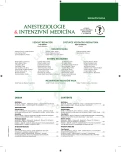The importance of thromboelastography (TEG) and thrombelastometry (ROTEM) in the intensive care unit
Authors:
Durila Miroslav; Lukáš Pavel; Pelichovská Martina; Vymazal Tomáš
Authors‘ workplace:
Klinika anesteziologie, resuscitace a intenzivní medicíny, FN Motol, 2. LF UK, Praha
Published in:
Anest. intenziv. Med., 25, 2014, č. 3, s. 216-221
Category:
Intesive Care Medicine - Case Report
Overview
Prolonged coagulation tests (INR and APTT) are a common occurrence in ITU patients. Thromboelastography (TEG) and rotational tromboelastometry (ROTEM) have been used since the last century in various fields of medicine. Unlike conventional laboratory tests they assess the function of other blood components especially the platelets. In this article we highlight the importance of TEG/ROTEM in intensive medicine. We present cases where this methodology proved to be more reliable than conventional tests both pre-operatively, postoperatively or in the differential diagnosis of bleeding events. Using this methodology in these and many other cases we were able to avoid unnecessary administration of frozen plasma and platelets, which would otherwise be administered to patients to correct laboratory coagulopathy of various origin. We reduced the risks associated with the administration of blood products to the patient and saved considerable financial resources.
Keywords:
thromboelastography – rotational tromboelastometry – coagulopathy
Sources
1. Levi, M., Opal, S. M. Coagulation abnormalities in critically ill patients. Crit. Care, 2006, 10 (4), p. 222.
2. Pivalizza, E. G. et al. Discrepancy between thromboelastography and prothrombin time. Anesthesiology, 1996, 84 (5), p. 1262.
3. Kozek-Langenecker, S. A. et al. Management of severe perioperative bleeding: Guidelines from the European Society of Anaesthesiology. Eur. J. Anaesthesiol., 2013, 30 (6), p. 270–382.
4. Durila, M., Malošek, M. Rotational thromboelastometry (ROTEM) along with thromboelastography (TEG) play critical role in the management of traumatic bleeding. Am. J. Emerg. Med., 2013, doi:10.1016/j.ajem.2013.09.038.
5. Sarani, B. et al. Transfusion of fresh frozen plasma in critically ill surgical patients is associated with an increased risk of infection. Crit. Care Med., 2008, 36 (4), p. 1114–1118.
6. Liang, H. et al. The effects of preloading infusion with hydroxyethyl starch 200/0.5 or 130/0.4 solution on hypercoagulability and excessive platelet activation of patients with colon cancer. Blood Coagul Fibrinolysis, 2010, 21 (5), p. 406–413.
7. Senzolo, M. et al. The effects of glycosaminoglycans on coagulation: a thromboelastographic study. Blood Coagul Fibrinolysis, 2007, 18 (3), p. 227–236.
8. Venema, L. F. et al. An assessment of clinical interchangeability of TEG and RoTEM thromboelastographic variables in cardiac surgical patients. Anesth. Analg., 2010, 111 (2), p. 339–344.
9. Iselin, B. M. et al. Isolated reduction of haematocrit does not compromise in vitro blood coaagulation. Br. J. Anaesth., 2001, 87 (2), p. 246–249.
10. Peyrou, V. et al. Contribution of erythrocytes to thrombin generation in whole blood. Thromb Haemost, 1999, 81 (3), p. 400–406.
11. Durila, M. et al. Heparinase-modified thromboelastography can result in a fibrinolytic pattern. Anaesthesia, 2010, 65 (8), p. 864–865.
12. Michiels, J. J. et al. Acquired von Willebrand syndrome in systemic lupus erythematodes. ClinHYPERLINK „http://www.ncbi.nlm.nih.gov/pubmed/11292186“ HYPERLINK „http://www.ncbi.nlm.nih.gov/pubmed/11292186“ApplHYPERLINK „http://www.ncbi.nlm.nih.gov/pubmed/11292186“ HYPERLINK „http://www.ncbi.nlm.nih.gov/pubmed/11292186“ThrombHYPERLINK „http://www.ncbi.nlm.nih.gov/pubmed/11292186“ HYPERLINK „http://www.ncbi.nlm.nih.gov/pubmed/11292186“HemostHYPERLINK „http://www.ncbi.nlm.nih.gov/pubmed/11292186“, 2001, 7, 2, p. 106–112.
Labels
Anaesthesiology, Resuscitation and Inten Intensive Care MedicineArticle was published in
Anaesthesiology and Intensive Care Medicine

2014 Issue 3
Most read in this issue
- Postdural puncture headache in obstetrics
- The importance of thromboelastography (TEG) and thrombelastometry (ROTEM) in the intensive care unit
- Bougie-assisted cricothyrotomy on an animal model – a pilot study
- Candid sepsis as a complication in a polytrauma patient
